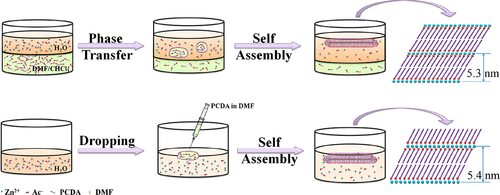Our official English website, www.x-mol.net, welcomes your
feedback! (Note: you will need to create a separate account there.)
Lamellar Nanosheets of Water-Insoluble Amphiphiles via Aqueous Solution and Air/Liquid Interface Self-Assembly.
Langmuir ( IF 3.7 ) Pub Date : 2020-08-24 , DOI: 10.1021/acs.langmuir.0c02168 Shuman Li 1 , Hong-Guo Liu 1
Langmuir ( IF 3.7 ) Pub Date : 2020-08-24 , DOI: 10.1021/acs.langmuir.0c02168 Shuman Li 1 , Hong-Guo Liu 1
Affiliation

|
Two-dimensional (2D) lamellar nanostructures have attracted much interest due to their unique structure and properties. Various fabrication methods have been developed in recent years, including solution self-assembly, exfoliation, and Langmuir monolayer and Langmuir–Blodgett (LB) deposition. In this work, two kinds of facile methods were applied to fabricate lamellar structures of amphiphilic molecules, such as 10,12-pentacosadiynoic acid (PCDA). In method I, the amphiphilic molecules were introduced into aqueous solutions with dimethylformamide (DMF), a solvent miscible with water, through a mass transfer process across a planar liquid/liquid interface; in method II, the DMF solution of the amphiphilic molecules was added directly onto the aqueous solution surface. With the spread and diffusion of DMF, nanosheets with lamellar structures formed in the aqueous solution and at the air/liquid interface, respectively. It is very interesting that the nanosheets obtained through these two methods consist of an even number and odd number of PCDA monolayers, respectively, reflecting different fabrication mechanisms. Method I provides an approach to gently mix organic solutions with aqueous solutions, while method II can be regarded as an extension of the Langmuir monolayer technique, which combines the interfacial assembly with that in solution. These methods have been extended to a series of amphiphilic molecules, and ordered layered structures have been obtained successfully.
中文翻译:

水不溶性两亲物的层状纳米片通过水溶液和空气/液体界面的自组装形成。
二维(2D)层状纳米结构因其独特的结构和性能而引起了人们的极大兴趣。近年来,已经开发出各种制造方法,包括溶液自组装,剥离,Langmuir单层和Langmuir-Blodgett(LB)沉积。在这项工作中,两种简便的方法被用于制造两亲性分子的层状结构,例如10,12-戊二十二碳二烯酸(PCDA)。在方法I中,通过在平面液/液界面上的传质过程,将两亲分子与二甲基甲酰胺(DMF)(一种可与水混溶的溶剂)引入水溶液中。在方法II中,将两亲分子的DMF溶液直接加入到水溶液表面上。随着DMF的传播和扩散,具有片状结构的纳米片分别在水溶液中和在空气/液体界面处形成。非常有趣的是,通过这两种方法获得的纳米片分别由偶数和奇数个PCDA单层组成,反映了不同的制造机理。方法I提供了一种将有机溶液与水溶液轻轻混合的方法,而方法II可以看作是Langmuir单层技术的扩展,该技术将界面组件与溶液中的组件结合在一起。这些方法已扩展到一系列两亲性分子,并已成功获得有序的分层结构。非常有趣的是,通过这两种方法获得的纳米片分别由偶数和奇数个PCDA单层组成,反映了不同的制造机理。方法I提供了一种将有机溶液与水溶液轻轻混合的方法,而方法II可以看作是Langmuir单层技术的扩展,该技术将界面组件与溶液中的组件结合在一起。这些方法已扩展到一系列两亲性分子,并已成功获得有序的分层结构。非常有趣的是,通过这两种方法获得的纳米片分别由偶数和奇数个PCDA单层组成,反映了不同的制造机理。方法I提供了一种将有机溶液与水溶液轻轻混合的方法,而方法II可以看作是Langmuir单层技术的扩展,该技术将界面组件与溶液中的组件结合在一起。这些方法已扩展到一系列两亲性分子,并已成功获得有序的分层结构。它结合了界面装配与溶液中的装配。这些方法已扩展到一系列两亲性分子,并已成功获得有序的分层结构。它结合了界面装配与溶液中的装配。这些方法已扩展到一系列两亲性分子,并已成功获得有序的分层结构。
更新日期:2020-09-15
中文翻译:

水不溶性两亲物的层状纳米片通过水溶液和空气/液体界面的自组装形成。
二维(2D)层状纳米结构因其独特的结构和性能而引起了人们的极大兴趣。近年来,已经开发出各种制造方法,包括溶液自组装,剥离,Langmuir单层和Langmuir-Blodgett(LB)沉积。在这项工作中,两种简便的方法被用于制造两亲性分子的层状结构,例如10,12-戊二十二碳二烯酸(PCDA)。在方法I中,通过在平面液/液界面上的传质过程,将两亲分子与二甲基甲酰胺(DMF)(一种可与水混溶的溶剂)引入水溶液中。在方法II中,将两亲分子的DMF溶液直接加入到水溶液表面上。随着DMF的传播和扩散,具有片状结构的纳米片分别在水溶液中和在空气/液体界面处形成。非常有趣的是,通过这两种方法获得的纳米片分别由偶数和奇数个PCDA单层组成,反映了不同的制造机理。方法I提供了一种将有机溶液与水溶液轻轻混合的方法,而方法II可以看作是Langmuir单层技术的扩展,该技术将界面组件与溶液中的组件结合在一起。这些方法已扩展到一系列两亲性分子,并已成功获得有序的分层结构。非常有趣的是,通过这两种方法获得的纳米片分别由偶数和奇数个PCDA单层组成,反映了不同的制造机理。方法I提供了一种将有机溶液与水溶液轻轻混合的方法,而方法II可以看作是Langmuir单层技术的扩展,该技术将界面组件与溶液中的组件结合在一起。这些方法已扩展到一系列两亲性分子,并已成功获得有序的分层结构。非常有趣的是,通过这两种方法获得的纳米片分别由偶数和奇数个PCDA单层组成,反映了不同的制造机理。方法I提供了一种将有机溶液与水溶液轻轻混合的方法,而方法II可以看作是Langmuir单层技术的扩展,该技术将界面组件与溶液中的组件结合在一起。这些方法已扩展到一系列两亲性分子,并已成功获得有序的分层结构。它结合了界面装配与溶液中的装配。这些方法已扩展到一系列两亲性分子,并已成功获得有序的分层结构。它结合了界面装配与溶液中的装配。这些方法已扩展到一系列两亲性分子,并已成功获得有序的分层结构。











































 京公网安备 11010802027423号
京公网安备 11010802027423号